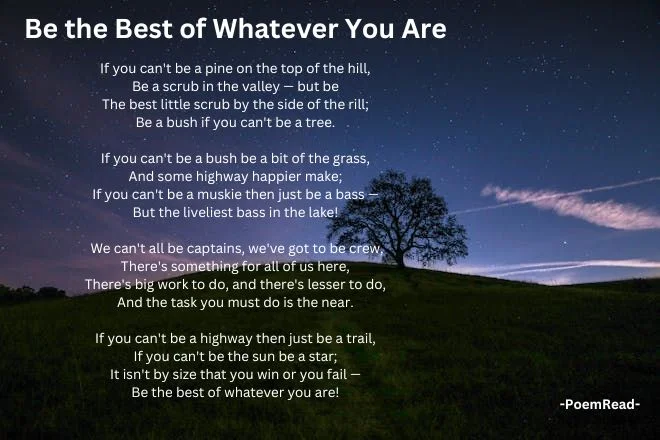
Welcome to this detailed analysis of the poem “Be the Best of Whatever You Are” by Douglas Malloch. In inspirational poetry, Douglas Malloch’s “Be the Best of Whatever You Are” shines as a guiding light, urging readers to embrace their uniqueness and strive for excellence regardless of their circumstances.
In this blog post, we will explore the various literature-related aspects of this inspiring piece. Let’s dive in and uncover the subject, the author, the context, the theme and tone, as well as the form and structure of the poem.
Be the Best of Whatever You Are by Douglas Malloch If you can't be a pine on the top of the hill, Be a scrub in the valley — but be The best little scrub by the side of the rill; Be a bush if you can't be a tree. If you can't be a bush be a bit of the grass, And some highway happier make; If you can't be a muskie then just be a bass — But the liveliest bass in the lake! We can't all be captains, we've got to be crew, There's something for all of us here, There's big work to do, and there's lesser to do, And the task you must do is the near. If you can't be a highway then just be a trail, If you can't be the sun be a star; It isn't by size that you win or you fail — Be the best of whatever you are!
Content
- The Author of "Be the Best of Whatever You Are" : Douglas Malloch
- Subject of "Be the Best of Whatever You Are"
- Context of "Be the Best of Whatever You Are"
- Theme and Tone of "Be the Best of Whatever You Are"
- Form and Structure of "Be the Best of Whatever You Are"
- Line-by-line Analysis of "Be the Best of Whatever You Are"
- Poetic and literary devices in "Be the Best of Whatever You Are"
- The implications of "Be the Best of Whatever You Are"
- Interactive Summary of "Be the Best of Whatever You Are"
- Conclusion
The Author of “Be the Best of Whatever You Are” : Douglas Malloch
Douglas Malloch, an American poet and journalist, was born on May 5, 1877, in Muskegon, Michigan. He was known for his ability to capture the essence of everyday life in his poems. Malloch’s works often celebrated the virtues of hard work, perseverance, and finding joy in one’s chosen path.
His diverse experiences, including working as an editor for several newspapers and contributing to various literary publications, enriched his perspective and influenced his poetic style. His writing style resonated with ordinary people, offering them inspiration and motivation through his heartfelt words.
Subject of “Be the Best of Whatever You Are”
“Be the Best of Whatever You Are” by Douglas Malloch delivers a compelling message centered on embracing one’s unique identity and maximizing personal potential. The poem employs a series of comparisons to convey the idea that, regardless of one’s circumstances or starting point in life, there is always room for growth and excellence.
Through metaphors like being a pine on a hill or a scrub in a valley, Malloch encourages readers to excel in their endeavors, emphasizing the importance of dedication and effort in achieving success. The poem’s central message is that true success is not merely defined by external factors or comparisons with others. Instead, the person’s dedication to becoming the best version of themselves determines it.
Context of “Be the Best of Whatever You Are”
During a time of societal and economic challenges, Douglas Malloch wrote, “Be the Best of Whatever You Are”. The early 20th century witnessed significant transformations due to rapid industrialization and shifting social dynamics. In such a context, Malloch’s poem resonated with individuals facing adversity and seeking personal growth.
The poem’s themes of resilience, determination, and the pursuit of excellence were particularly relevant during this era of change and uncertainty. Malloch’s message urges readers to embrace their unique qualities and make the most of their potential. This provides a source of inspiration and motivation for those navigating challenging circumstances.
Persona
In “Be the Best of Whatever You Are,” Douglas Malloch adopts the persona of a wise mentor or advisor, offering guidance and encouragement to the readers. The persona reflects a seasoned individual who has experienced life’s ups and downs and has gained insights into the importance of embracing one’s unique qualities. Through his persona, Malloch speaks directly to the audience, imparting timeless wisdom about the value of determination, resilience, and self-discovery.
The persona’s voice is characterized by a blend of empathy and authority. Thus, this creates a compelling narrative that resonates with individuals seeking inspiration and motivation. By using relatable metaphors and vivid imagery, the persona connects with readers on a personal level, urging them to strive for excellence and make the most of their potential. Overall, the persona in the poem serves as a beacon of guidance, encouraging readers to embrace their individuality and pursue their aspirations with vigor.
Setting
While “Be the Best of Whatever You Are” does not explicitly mention a specific setting, the poem’s themes and imagery evoke a sense of both natural and metaphorical landscapes. The references to elements like pines, valleys, rivers, bushes, and grass create a picturesque backdrop that symbolizes different stages or paths in life.
The setting can be interpreted as a metaphorical journey where individuals navigate through various challenges and opportunities. The mention of being a scrub in the valley or a bit of grass along a highway paints a picture of diverse environments, each offering its own set of possibilities and obstacles.
Furthermore, the setting can also be seen as reflective of the societal and economic context of the early 20th century, when the poem was written. The rapid industrialization and shifting social dynamics of that era influenced the mindset of individuals striving for personal and professional growth.
Overall, while the poem does not provide a specific physical setting, its imagery and metaphors create a rich backdrop that enhances the thematic elements of self-discovery, resilience, and the pursuit of excellence.
Theme and Tone of “Be the Best of Whatever You Are”
The Theme: Celebrating Individuality and Excellence
Douglas Malloch’s poem “Be the Best of Whatever You Are” is a powerful ode to individuality and the pursuit of excellence. The theme is clear and uplifting: it encourages every person to strive for excellence in whatever role they play, no matter how big or small. Malloch’s message is one of empowerment, urging us to find our unique place in the world and to fill it with our best efforts.
The poem’s theme is particularly resonant in today’s society, where success is often measured by comparison with others. Malloch turns this notion on its head, suggesting that true success comes from being the best version of ourselves, not from outdoing someone else. It’s a call to personal greatness that acknowledges the diverse spectrum of human potential.
The Tone: Encouraging and Affirmative
The tone of Malloch’s poem is both encouraging and affirmative. It’s written with a warmth that feels like a gentle pat on the back, a reassurance that as long as you’re doing your best, you’re succeeding. The poet’s choice of simple yet vivid language creates an intimate conversation with the reader, one that’s both inspiring and comforting.
Malloch’s tone doesn’t just motivate; it validates. It recognizes the inherent value in every person’s contribution, no matter the scale. This validation is crucial, as it fosters a sense of pride and purpose in the reader. Furthermore, this encourages them to embrace their role with enthusiasm and confidence.
Form and Structure of “Be the Best of Whatever You Are”
“Be the Best of Whatever You Are” is composed of four quatrains, each with a clear and rhythmic AABB rhyme scheme. The poem’s structure is straightforward, mirroring the simplicity of its message. The use of pauses and line breaks emphasizes the reflective nature of the poem, while the minimal punctuation ensures a smooth and natural flow of reading.
Malloch’s deliberate choice of rhyme and rhythm creates a memorable and recitable piece. This encourages readers to carry its impactful message in their hearts and minds long after reading the poem. The consistency of the rhyme scheme throughout the poem reinforces the steadfastness of the poem’s message: to be steadfast in our pursuit of being our best selves.
Additionally, the poem maintains a consistent meter, predominantly iambic tetrameter, with four metrical feet per line. This structured form allows for a cohesive presentation of Malloch’s ideas while maintaining a lyrical quality that engages the reader.
Line-by-line Analysis of “Be the Best of Whatever You Are”

“If you can’t be a pine on the top of the hill,”
This line presents a metaphorical comparison between being a “pine on the top of the hill” and a desirable position of success or prominence in life. It implies that not everyone can achieve the highest level of success, but that’s okay.
“Be a scrub in the valley — but be”
Here, the poet suggests that even if one cannot reach the pinnacle of success, they should not lose hope. Being a “scrub in the valley” represents a humble position, yet it carries the message of making the most of one’s circumstances.
“The best little scrub by the side of the rill;”
The emphasis shifts to excellence in whatever role or position one finds themselves in. The phrase “the best little scrub” underscores the importance of putting in effort and striving for excellence, regardless of the scale or visibility of the task. The ‘side of the rill’ suggests a nurturing environment where one can thrive.
“Be a bush if you can’t be a tree.”
This line continues the theme of embracing one’s limitations while still aiming for greatness. Being a “bush” signifies a smaller stature compared to a “tree,” yet it implies that one can still thrive and contribute in their own way.
Again, the comparison between a ‘bush’ and a ‘tree’ highlights the difference between what is considered significant and what is not. Malloch’s message is clear: value lies not in what you are but in how well you fulfill your role.
“If you can’t be a bush be a bit of the grass,”
Here, the poem continues with the theme of scaling down aspirations to fit reality. The poet extends the metaphor further, suggesting that even if one cannot achieve a significant role like a bush, they can still find purpose and value as “a bit of the grass.” This line emphasizes the importance of humility and finding fulfillment in any role.
“And some highway happier make;”
This line introduces the idea of making others’ lives better, even if one’s own ambitions are more modest. “Some highway happier make” suggests contributing positively to the world around us, regardless of our personal achievements.
“If you can’t be a muskie then just be a bass —”
The metaphor shifts to aquatic life, comparing the roles of a “muskie” and a “bass.” The ‘muskie’ is a larger, more prized fish compared to the ‘bass.’ This line provides the idea that being a smaller or less notable version is still worthy. This line reinforces the message of embracing one’s limitations and finding contentment in whatever role or position one occupies.
“But the liveliest bass in the lake!”
The poet concludes the stanza with an exclamation, emphasizing the importance of being ‘the liveliest’ or the best, even if one is just a ‘bass.’ It’s about standing out through one’s unique qualities.
The focus here is on being the best version of oneself, even if it means playing a smaller role. Being “the liveliest bass” signifies bringing enthusiasm, energy, and vitality to whatever one does, regardless of external measures of success.
“We can’t all be captains, we’ve got to be crew,”
The poet acknowledges the diversity of roles and positions in life, emphasizing the importance of teamwork and collaboration. Not everyone can be a leader (“captain”), but each person plays a valuable part (“crew”) in achieving collective goals.
“There’s something for all of us here,”
This line reinforces the idea that everyone has a purpose and a role to play in the grand scheme of things. It encourages readers to recognize and appreciate their unique contributions to the world.
“There’s big work to do, and there’s lesser to do,”
The poet contrasts between significant (“big”) and less significant (“lesser”) tasks, suggesting that every task, no matter how small, contributes to the greater good. It promotes a sense of purpose and value in all endeavors.
“And the task you must do is the near.”
This line emphasizes the importance of focusing on the tasks at hand (“the near”) and giving them one’s best effort. It encourages readers to prioritize their responsibilities and make a meaningful impact on their immediate surroundings.
“If you can’t be a highway then just be a trail,”
The metaphorical comparison shifts to transportation, comparing being a “highway” to a prominent and well-known path, while being a “trail” signifies a smaller and less traveled path. This line reinforces the idea of finding fulfillment in any role or position, no matter its scale or visibility.
“If you can’t be the sun be a star;”
This line encourages readers to shine in their own way, even if they cannot achieve the highest level of greatness (“the sun”). Being a “star” signifies bringing brightness and positivity to one’s environment, regardless of external recognition.
“It isn’t by size that you win or you fail —”
Here, the poet challenges conventional notions of success and failure based solely on external measures. The message is that impact and value are more important than size or stature in determining one’s true success.
“Be the best of whatever you are!”
The concluding line serves as a powerful mantra, encapsulating the overarching message of the poem. It emphasizes the importance of striving for excellence and making the most of one’s unique qualities and circumstances.
Poetic and literary devices in “Be the Best of Whatever You Are”
Metaphor
The poem is rich in metaphors, where various elements of nature are used to symbolize different stages or roles in life. For example, “If you can’t be a pine on the top of the hill, Be a scrub in the valley” uses the metaphor of a pine tree and a scrub to represent different levels of success or prominence. These metaphors add depth to the poem’s imagery and make the message more relatable.
Imagery
Malloch’s use of vivid imagery helps paint a clear picture in the reader’s mind. Descriptions like “scrub in the valley,” “bush,” “highway,” and “muskie” create visual scenes that enhance the thematic elements of the poem. The imagery not only engages the senses but also reinforces the idea of embracing one’s unique path and potential.
Repetition
The poem uses repetition effectively to emphasize key points and reinforce the central message. The phrase “Be the best” is repeated throughout the poem, serving as a mantra that encourages readers to strive for excellence in whatever they do. This repetition adds rhythm and emphasis to the poem’s tone and theme.
Rhyme Scheme
“Be the Best of Whatever You Are” follows a consistent AABB rhyme scheme in each quatrain, contributing to its musicality and flow. The rhyming words help create a sense of cohesion and structure within the poem, making it memorable and easy to recite.
Assonance
Assonance refers to the repetition of vowel sounds within words. In the poem, there are instances of assonance that contribute to the poem’s musicality and rhythm. For example, in the line “Be a scrub in the valley,” the short “e” sound in “be,” “scrub,” and “valley” creates assonance.
Consonance
Consonance involves the repetition of consonant sounds within words. While the poem does not heavily rely on consonance, there are occasional instances, such as in the line “The best little scrub by the side of the rill,” where the repeated “b” and “r” sounds create consonance.
Parallelism
The poem employs parallelism by presenting contrasting scenarios in each stanza. For instance, “If you can’t be a bush be a bit of the grass, And some highway happier make” juxtaposes being a bush with being a bit of grass, highlighting the idea that every role or position has its own value and potential for impact.
Alliteration
There are instances of alliteration in the poem, where the repetition of consonant sounds adds a lyrical quality to the verses. For example, “scrub in the valley” and “be a star” showcase the use of alliteration, enhancing the poem’s rhythm and musicality.
Symbolism
Beyond the natural elements used in the metaphors, certain symbols carry deeper meanings in the poem. For instance, the “highway” and “star” symbolize paths of progress and achievement, while the “sun” represents greatness and influence. These symbols enrich the thematic exploration of individual growth and contribution.
Antithesis
Antithesis involves the juxtaposition of contrasting ideas or words within a sentence or stanza. The poem utilizes antithesis effectively to highlight contrasts and emphasize the message of embracing one’s circumstances while striving for excellence. For example, the contrast between being a “pine on the top of the hill” and a “scrub in the valley” presents an antithesis of success and humility.
Transferred Epithet
A transferred epithet occurs when an adjective that grammatically modifies one noun actually describes another noun. In the line “The best little scrub by the side of the rill,” the epithet “best” is transferred from describing the scrub to emphasizing the quality of excellence in the person being addressed.
Overall, the strategic use of these poetic and literary devices contributes to the poem’s effectiveness in delivering a timeless message of self-discovery, resilience, and the pursuit of excellence.
The implications of “Be the Best of Whatever You Are”

Embracing Individuality
One of the primary implications of the poem is the importance of embracing one’s individuality. Malloch’s comparisons between different elements of nature, such as pines, bushes, and grass, underscore the idea that each person has unique qualities and strengths. By encouraging readers to be the best version of themselves, regardless of their societal roles or perceived limitations, the poem promotes self-acceptance and authenticity.
Resilience and Determination
The poem’s message of resilience and determination is another significant implication. Malloch emphasizes that one’s dedication and effort, rather than external factors or comparisons with others, determine success. This theme resonates with individuals facing challenges or setbacks, reminding them of the importance of perseverance and a positive mindset in overcoming obstacles.
Equality of Opportunities
Through the metaphorical comparisons in the poem, Malloch suggests that everyone has opportunities for growth and achievement, regardless of their starting point. Whether one is a “pine on the top of the hill” or a “scrub in the valley,” there is value in striving for excellence and making a positive impact in one’s chosen sphere of influence. This promotes a sense of equality and inclusivity, emphasizing that success is attainable by anyone willing to put in the work.
Motivation and Inspiration
“Be the Best of Whatever You Are” serves as a source of motivation and inspiration for readers seeking guidance in their personal and professional lives. The encouraging tone and uplifting language used by Malloch instill a sense of purpose and drive, encouraging individuals to pursue their goals with enthusiasm and determination. This implication reinforces the idea that self-belief and dedication are key factors in achieving success.
Timeless Relevance
Despite being written in a specific historical context, the poem’s themes and implications have a timeless relevance that transcends generations. The universal message of self-discovery, resilience, and the pursuit of excellence makes the poem relatable to people of all ages and backgrounds. Its enduring popularity underscores its enduring value as a literary work that continues to inspire and empower readers worldwide.
In summary, the implications of “Be the Best of Whatever You Are” extend beyond its words, offering readers valuable lessons about self-acceptance, perseverance, and the limitless potential within each individual.
Interactive Summary of “Be the Best of Whatever You Are”
“Be the Best of Whatever You Are” by Douglas Malloch is an inspiring poem that encourages readers to embrace their uniqueness and strive for excellence in all aspects of life. Through vivid metaphors and powerful imagery, the poem delivers a timeless message of resilience, determination, and self-discovery.
Imagine standing at a crossroads in life, unsure of your path forward. The poem’s persona, a wise mentor, speaks directly to you, urging you to embrace your individuality. Whether you’re a towering pine on a hill or a humble scrub in a valley, the poem reminds you that each role has value and potential.
As you navigate through the poem’s rhythmic lines, you encounter vivid imagery of nature’s elements – pines, bushes, grass, highways, and stars. These symbols represent different stages and opportunities in life, each offering a chance to make a meaningful impact.
Through repetition and parallelism, the poem emphasizes the importance of dedication and effort in achieving success. The rhythmic AABB rhyme scheme adds a musical quality to the verses, making the message both memorable and uplifting.
The persona’s encouraging tone evolves from gentle guidance to passionate encouragement, instilling a sense of motivation and purpose. You’re reminded that success isn’t measured by external standards but by your commitment to being the best version of yourself.
As you reflect on the poem’s deeper meaning, you realize its timeless relevance. Whether written in the early 20th century or read today, its message resonates with individuals facing challenges and seeking personal growth.
In conclusion, “Be the Best of Whatever You Are” serves as a beacon of inspiration, guiding you to embrace your uniqueness, persevere through obstacles, and strive for greatness in whatever path you choose.
Conclusion
In closing, Douglas Malloch’s “Be the Best of Whatever You Are” is a timeless source of inspiration that resonates deeply with readers. Through its powerful message of embracing individuality and resilience, the poem encourages personal growth and determination.
Malloch’s skilled use of literary devices and relatable comparisons creates an interactive experience, inviting readers to reflect on their own journeys. The poem’s enduring relevance transcends time, offering universal truths about human potential and the pursuit of excellence.
Ultimately, “Be the Best of Whatever You Are” inspires individuals to embrace their uniqueness, overcome obstacles, and strive for personal growth. So, let us all take these words to heart and be the best of whatever we are!
To read more of our poem reviews on various aspects of life, please visit Life – PoemRead
RELATED POSTS
View all



